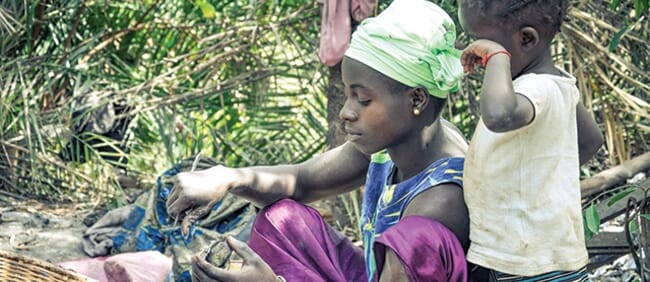
Gambia's oyster industry is dominated by smallholders © FISH4ACP
Sustainable growth of The Gambia’s oyster sector depends on better production and responsible resource management, according to an upgrading strategy presented to 50 experts and stakeholders on 28 September. It will improve the livelihoods of the women who dominate this small-scale sector and can turn the tide on declining oyster stocks.
“This plan fits perfectly in Gambia’s ambition of making its fisheries more sustainable and improve the food and nutrition security of our population,” said Omar Gibba, permanent secretary, Ministry of Fisheries, Water Resources and National Assembly Matters, at the start of a meeting where a 10-year strategy to upgrade Gambia’s oyster value chain was presented. He added, “it will benefit small-scale producers in particular, most of them women, who can feed their families and improve their livelihoods.”
The strategy results from a collaborative effort between key stakeholders involved in The Gambia’s oyster sector, spearheaded by FISH4ACP, a global fish value chain development initiative of the Organisation of African, Caribbean and Pacific States (OACPS) implemented by FAO with funding from the European Union (EU) and the German Federal Ministry for Economic Cooperation and Development (BMZ).

© FISH4ACP
“Promoting economic and social benefits for small-scale oyster producers in an environmentally friendly way is a great example of sustainable development that the European Union supports,” said Evangelina Blanco González, programme manager at the EU Delegation to the Gambia.
The upgraded strategy outlines an ambitious agenda for sustainable growth of oyster production in The Gambia over the next ten years, beyond FISH4ACP own duration until 2025. Growth is possible, because increasing demand in the local market can be met by strengthening The Gambia’s long-standing tradition in oyster production.
Any future development, however, depends on responsible management of natural resources to address decreasing oyster stocks, according to the plan. The Tanbi Wetland at the mouth of the Gambia River, one of the main oyster production areas, is a priority. Updating this area’s management plan will enable to harvest wild oyster sustainably, without adding pressure on the mangroves where oyster grow.
Important production gains are envisaged in oyster aquaculture, still in its infancy. Research will help identify the most suitable methods, as well as the areas to expand oyster farming. Likewise, economic growth will benefit from increased marketing, developing new products and new marketing channels for oysters and by-products, such as oyster shells.
“This strategy can bring economic prosperity and social well-being to small-scale women producers, while safeguarding resources for future generations,” said Moshibudi Rampedi, FAO Representative in The Gambia.
During the next two days, experts and stakeholders will engage in detailed discussions on new markets and products for oysters, on product safety and hygiene, on access to finance, equipment and infrastructure, on building capacities of value chain actors, on improved oyster resource and mangrove ecosystem monitoring and management. The official endorsement of the strategy is expected later this year.




